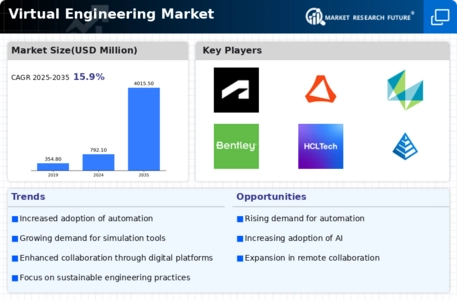-
EXECUTIVE SUMMARY
-
Market Attractiveness Analysis
- Global Virtual Engineering Market, by Software Type
- Global
-
Virtual Engineering Market, by Deployment Type
-
Global Virtual Engineering
-
Market, by Organization Size
-
Vertical
-
Global Virtual Engineering Market, by Industry
-
Global Virtual Engineering Market, by Industry Vertical
-
Global Virtual Engineering Market, by Region
-
MARKET INTRODUCTION
-
Definition
-
Scope of the Study
-
Market Structure
-
Key Buying Criteria
-
Macro Factor Indicator Analysis
-
RESEARCH METHODOLOGY
-
Research Process
-
Primary Research
-
Secondary Research
-
Market Size Estimation
-
Forecast Model
-
List of Assumptions
-
MARKET DYNAMICS
-
Introduction
-
Drivers
- Adoption
- Robust Demand for Computer-Aided Design (CAD)
- Drivers Impact Analysis
-
of Cloud Based Software
-
Software
-
Restraints
- Piracy
- Lack of Skilled Personnel
- Restraints Impact Analysis
-
Issues
-
Opportunities
- Rising Demand for 3D Modelling
-
Impact
- Impact on the various engineering software demand
- Impact on technology development
-
of COVID-19
-
Impact on industry verticals
-
YOY growth 2020-2030
-
MARKET FACTOR ANALYSIS
-
Value Chain Analysis/Supply
-
Chain Analysis
-
Porter’s Five Forces Model
-
Bargaining Power
-
of Suppliers
-
Bargaining Power of Buyers
-
Threat of New Entrants
-
Threat of Substitutes
-
Intensity of Rivalry
-
GLOBAL VIRTUAL
-
ENGINEERINGMARKET MARKET, BY SOFTWARE TYPE
-
Introduction
-
Computer-Aided
-
Designing (CAD)
-
Computer-Aided Manufacturing (CAM)
-
Computer-Aided
-
Engineering (CAE)
-
Architecture, Engineering and Construction (AEC)
-
Electronic Design Automation (EDA)
-
GLOBAL VIRTUAL ENGINEERINGMARKET
-
MARKET, BY DEPLOYMENT TYPE
-
Introduction
-
On-premises
-
Cloud
-
GLOBAL VIRTUAL ENGINEERINGMARKET MARKET, BY ORGANIZATION SIZE
-
Introduction
-
SME’s
-
Large Enterprises
-
GLOBAL VIRTUAL
-
ENGINEERINGMARKET MARKET, BY APPLICATION
-
Introduction
-
Automation
-
Design
-
Plant Design
-
Product Design
-
3D Modelling
-
Others
-
GLOBAL VIRTUAL ENGINEERINGMARKET, BY INDUSTRY VERTICAL
-
Introduction
-
Aerospace & Defense
-
Automotive
-
Banking
-
IT & Telecommunication
-
Oil & Gas
-
Healthcare
-
Others
-
GLOBAL VIRTUAL ENGINEERINGMARKET,
-
BY REGION
-
Introduction
-
North America
- Market Estimates
- Market Estimates &
- Market Estimates &
- Market Estimates &
- Market Estimates &
- Market Estimates & Forecast,
- US
- Canada
-
& Forecast, by Country, 2019–2032
-
Forecast, by Software type, 2019–2032
-
Forecast, by Deployment type, 2019–2032
-
Forecast, by Organization Size, 2019–2032
-
Forecast, by Application, 2019–2032
-
by Industry Vertical, 2019–2032
-
& Forecast, by Software type, 2019–2032
-
& Forecast, by Deployment type, 2019–2032
-
& Forecast, by Organization Size, 2019–2032
-
& Forecast, by Application, 2019–2032
-
& Forecast, by Industry Vertical, 2019–2032
-
Market Estimates & Forecast, by Software type, 2019–2032
-
Market Estimates & Forecast, by Deployment type, 2019–2032
-
Market Estimates & Forecast, by Organization Size, 2019–2032
-
Market Estimates & Forecast, by Application, 2019–2032
-
Market Estimates & Forecast, by Industry Vertical, 2019–2032
-
Mexico
-
Market Estimates & Forecast, by Software type, 2019–2032
-
Market Estimates & Forecast, by Deployment type, 2019–2032
-
Market Estimates & Forecast, by Organization Size, 2019–2032
-
Market Estimates & Forecast, by Application, 2019–2032
-
Market Estimates & Forecast, by Industry Vertical, 2019–2032
-
Europe
- Market Estimates & Forecast, by Country, 2019–2032
- Market Estimates & Forecast, by Software type, 2019–2032
- Market Estimates & Forecast, by Deployment type, 2019–2032
- Market Estimates & Forecast, by Organization Size, 2019–2032
- Market Estimates & Forecast, by Application, 2019–2032
-
Market Estimates & Forecast, by Industry Vertical, 2019–2032
-
Germany
-
Size, 2019–2032
-
by Software type, 2019–2032
-
by Deployment type, 2019–2032
-
by Organization Size, 2019–2032
-
by Application, 2019–2032
-
by Industry Vertical, 2019–2032
-
Estimates & Forecast, by Software type, 2019–2032
-
Estimates & Forecast, by Deployment type, 2019–2032
-
Estimates & Forecast, by Organization Size, 2019–2032
-
Market Estimates & Forecast, by Software type, 2019–2032
-
Market Estimates & Forecast, by Deployment type, 2019–2032
-
Market Estimates & Forecast, by Organization Size, 2019–2032
-
Market Estimates & Forecast, by Application, 2019–2032
-
Market Estimates & Forecast, by Industry Vertical, 2019–2032
-
UK
-
Market Estimates & Forecast, by Software type, 2019–2032
-
Market Estimates & Forecast, by Deployment type, 2019–2032
-
Market Estimates & Forecast, by Organization Size, 2019–2032
-
Market Estimates & Forecast, by Application, 2019–2032
-
Market Estimates & Forecast, by Industry Vertical, 2019–2032
-
France
-
Market Estimates & Forecast, by Software type,
-
Market Estimates & Forecast, by Deployment type,
-
Market Estimates & Forecast, by Organization
-
Market Estimates & Forecast, by Application,
-
Market Estimates & Forecast, by Industry Vertical,
-
Italy
-
Market Estimates & Forecast,
-
Market Estimates & Forecast,
-
Market Estimates & Forecast,
-
Market Estimates & Forecast,
-
Market Estimates & Forecast,
-
Spain
-
Market
-
Market
-
Market
-
Market Estimates & Forecast, by Application, 2019–2032
-
Market Estimates & Forecast, by Industry Vertical, 2019–2032
-
Rest of Europe
-
Size, 2019–2032
-
by Country, 2019–2032
-
type, 2019–2032
-
type, 2019–2032
-
Size, 2019–2032
-
by Software type, 2019–2032
-
by Deployment type, 2019–2032
-
by Organization Size, 2019–2032
-
by Application, 2019–2032
-
by Industry Vertical, 2019–2032
-
& Forecast, by Software type, 2019–2032
-
& Forecast, by Deployment type, 2019–2032
-
& Forecast, by Organization Size, 2019–2032
-
& Forecast, by Application, 2019–2032
-
& Forecast, by Industry Vertical, 2019–2032
-
Market Estimates & Forecast, by Software type,
-
Market Estimates & Forecast, by Deployment type,
-
Market Estimates & Forecast, by Organization
-
Market Estimates & Forecast, by Application,
-
Market Estimates & Forecast, by Industry Vertical,
-
Asia-Pacific
- Market Estimates & Forecast,
- Market Estimates & Forecast, by Software
- Market Estimates & Forecast, by Deployment
- Market Estimates & Forecast, by Organization
- Market Estimates & Forecast, by Application,
- Market Estimates & Forecast, by Industry Vertical,
- China
- Japan
- India
-
Market Estimates & Forecast, by Software type, 2019–2032
-
Market Estimates & Forecast, by Deployment type, 2019–2032
-
Market Estimates & Forecast, by Organization Size, 2019–2032
-
Market Estimates & Forecast, by Application, 2019–2032
-
Market Estimates & Forecast, by Industry Vertical, 2019–2032
-
Rest of Asia-Pacific
-
type, 2019–2032
-
type, 2019–2032
-
Size, 2019–2032
-
& Forecast, by Software type, 2019–2032
-
& Forecast, by Deployment type, 2019–2032
-
& Forecast, by Organization Size, 2019–2032
-
& Forecast, by Application, 2019–2032
-
Forecast, by Industry Vertical, 2019–2032
-
Market Estimates & Forecast, by Software
-
Market Estimates & Forecast, by Deployment
-
Market Estimates & Forecast, by Organization
-
Market Estimates & Forecast, by Application,
-
Market Estimates & Forecast, by Industry Vertical,
-
Middle East and Africa
- Market Estimates
- Market Estimates
- Market Estimates
- Market Estimates
- Market Estimates &
-
South America
-
Market Estimates & Forecast, by Software type, 2019–2032
-
Market Estimates & Forecast, by Deployment type, 2019–2032
-
Market Estimates & Forecast, by Organization Size, 2019–2032
-
Market Estimates & Forecast, by Application, 2019–2032
-
Estimates & Forecast, by Industry Vertical, 2019–2032
-
Market
-
COMPETITIVE
-
LANDSCAPE
-
Introduction
-
Key Developments & Growth Strategies
-
Competitor Benchmarking
-
Vendor Share Analysis, 2022 (% Share)
-
COMPANY PROFILES
-
Siemens PLM Software
-
Dassault Systems
-
Ansys
-
Autodesk, Inc.
-
Altair Engineering, Inc.
-
Hexagon AB (MSC Software)
-
Bentley Systems
-
HCL Technologies
-
Carlson Software
-
PTC, IBM Corporation
-
Accenture
-
Bosch Rexroth
-
Capgemini
-
Others
- Financial Overview
- Organization Size/Services
- Key Developments
- SWOT Analysis
-
Company Overview
-
Offered
-
Key Strategies

















Leave a Comment